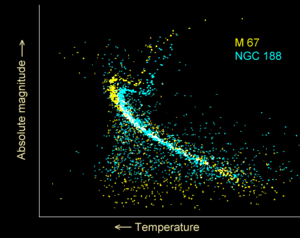Hertzsprung-Russell diagram
The Hertzsprung-Russell diagram (usually referred to by the abbreviation H-R diagram or HRD, also known as a colour-magnitude diagram, or CMD) shows the relationship between absolute magnitude, luminosity, classification, and effective temperature of stars. The diagram was created circa 1910 by Ejnar Hertzsprung and Henry Norris Russell, and represented a huge leap forward in understanding stellar evolution, or the 'lives of stars'.
Contents |
Diagram

Forms of diagram

There are several forms of the Hertzsprung-Russell diagram, and the nomenclature is not very well defined. The original diagram displayed the spectral type of stars on the horizontal axis and the absolute magnitude on the vertical axis. The first quantity (i.e. spectral type) is difficult to determine unambiguously and is therefore often replaced by the B-V colour index of the stars. This type of diagram is called a Hertzsprung-Russell diagram, or colour-magnitude diagram, and it is often used by observers. However, colour-magnitude diagram is also used in some cases to describe a plot with the vertical axis depicting the apparent, rather than the absolute, magnitude. Another form of the diagram plots the effective temperature of the star on one axis and the luminosity of the star on the other. This is what theoreticians calculate using computer models that describe the evolution of stars. This type of diagram should probably be called temperature-luminosity diagram, but this term is hardly ever used, the term Hertzsprung-Russell diagram being preferred instead. Despite some confusion regarding the nomenclature, astrophysicists make a strict distinction between these types of diagrams.
The reason for this distinction is that the exact transformation from one to the other is not trivial, and depends on the stellar-atmosphere model being used and its parameters (like composition and pressure, apart from temperature and luminosity). Also, one needs to know the distance to the observed objects and the interstellar reddening. Empirical transformation between various colour indices and effective temperature are available in literature (Sekiguchi 2000, Casagrande 2006).
The H-R diagram can be used to define different types of stars and to match theoretical predictions of stellar evolution using computer models with observations of actual stars. It is then necessary to convert either the calculated quantities to observables, or the other way around, thus introducing an extra uncertainty.
Interpretation
Most of the stars occupy the region in the diagram along the line called main sequence. During that stage stars are fusing hydrogen in their cores. The next concentration of stars is on the horizontal branch (helium fusion in the core and hydrogen burning in a shell surrounding the core). Another prominent feature is the Hertzsprung gap located in the region between A5 and G0 spectral type and between +1 and −3 absolute magnitudes (i.e. between the top of the main sequence and the giants in the horizontal branch). RR Lyrae stars can be found in the left of this gap. Cepheid variables reside in the upper section of the instability strip.
The H-R diagram can also be used by scientists to roughly measure how far away a star cluster is from Earth. This can be done by comparing the apparent magnitudes of the stars in the cluster to the absolute magnitudes of stars with known distances (or of model stars). The observed group is then shifted in the vertical direction, until the two main sequences overlap. The difference in magnitude that was bridged in order to match the two groups is called the distance modulus and is a direct measure for the distance. This technique is known as main-sequence fitting, or, confusingly, as the spectroscopic parallax.
The diagram's role in the development of stellar physics
Contemplation of the diagram led astronomers to speculate that it might demonstrate stellar evolution, a main suggestion being that stars collapsed from red giants to dwarf stars, then moving down along the line of the main sequence in the course of their lifetimes. However, following Russell's presentation of the diagram to a meeting of the Royal Astronomical Society in 1912, Arthur Eddington was inspired to use it as a basis for developing ideas on stellar physics (Porter, 2003). In 1926, in his book The Internal Constitution of the Stars he explained the physics of how stars fit on the diagram. This was a particularly remarkable development since at that time the major problem of stellar theory, the source of a star's energy, was still unsolved. Thermonuclear energy, and even that stars are largely composed of hydrogen, had yet to be discovered. Eddington managed to sidestep this problem by concentrating on the thermodynamics of radiative transport of energy in stellar interiors (Smith, 1995). So, Eddington predicted that dwarf stars remain in an essentially static position on the main sequence for most of their lives. In the 1930s and 1940s, with a understanding of hydrogen fusion, came a physically-based theory of evolution to red giants, and white dwarfs. By this time, study of the Hertzsprung-Russell diagram did not drive such developments but merely allowed stellar evolution to be presented graphically.
See also
- Asymptotic Giant Branch
- Galaxy color-magnitude diagram
- Hayashi track
- Henyey track
- Hess diagram
- Red clump
- Stellar birthline
- Stellar classification
- Tip of the Red Giant Branch
- Color-color diagram
References
- Casagrande, L.; Portinari, L., and Flynn, C. (November 2006). "Accurate fundamental parameters for lower main-sequence stars" (Abstract). MNRAS 373 (1): 13–44. doi:. http://adsabs.harvard.edu/abs/2006astro.ph..8504C. Retrieved on 2007-02-06.
- Porter, Roy (2003). The Cambridge History of Science. Cambridge, UK: Cambridge University Press. pp. 518. ISBN 978-0521572439.
- Sekiguchi, Maki; Fukugita, Masataka (August 2000). "A Study of the B-V Color-Temperature Relation" (HTML). The Astronomical Journal 120 (2): 1072–1084. doi:. http://www.iop.org/EJ/article/1538-3881/120/2/1072/990160.html. Retrieved on 2008-09-14.
- Smith, Robert (1995). Observational Astrophysics. Cambridge, UK: Cambridge University Press. pp. 236. ISBN 978-0521278348.
External links
- JavaHRD an interactive Hertzsprung-Russell diagram as a Java applet
- BaSTI a Bag of Stellar Tracks and Isochrones, simulations with FRANEC code by Teramo Astronomical Observatory
- Leos Ondra: The first Hertzsprung-Russell diagram